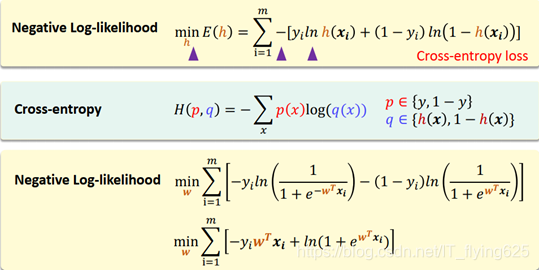- 回顾Logistic Regression的基本原理
- 关于sigmoid函数

- 极大似然与损失函数

- 牛顿法


- 实验步骤与过程
- 首先,读入数据并绘制原始数据散点图

根据图像,我们可以看出,左下大多为负样本,而右上多为正样本,划分应该大致为一个斜率为负的直线。
- 定义预测方程:
此处使用sigmoid函数,定义为匿名函数(因为在MATLAB中内联函数即将被淘汰)
![]()
- 定义损失函数和迭代次数
损失函数:

参数更新规则:

梯度:

注意:其中,参数theta初始化为0,初始定义迭代次数为20,然后观察损失函数,调整到合适的迭代次数,发现当迭代次数达到6左右,就已经收敛。
- 计算结果:通过迭代计算theta
theta = zeros(n+1, 1); %theta 3x1
iteration=8
J = zeros(iteration, 1);
for i=1:iteration
z = x*theta; %列向量 80x1 x 80x3 y 80x1
J(i) =(1/m)*sum(-y.*log(g(z)) - (1-y).*log(1-g(z)));
H = (1/m).*x'*(diag(g(z))*diag(g(-z))*x);%3x3 转换为对角矩阵
delta=(1/m).*x' * (g(z)-y);
theta=theta-H\delta
%theta=theta-inv(H)*delta
end
计算得到的theta值为:
theta = 3×1
-16.3787
0.1483
0.1589
绘制图像如下:

关于损失函数值与迭代次数的变化

预测:
预测成绩1为20,成绩二维80不被录取的概率:
prob = 1 - g([1, 20, 80]*theta)
计算得:
prob = 0.6680
即不被录取的概率为0.6680.
MATLAB源代码
clc,clear
x=load('ex4x.dat')
y=load('ex4y.dat')
[m, n] = size(x);
x = [ones(m, 1), x];%增加一列
% find returns the indices of the
% rows meeting the specified condition
pos = find(y == 1); neg = find(y == 0);
% Assume the features are in the 2nd and 3rd
% columns of x
plot(x(pos, 2), x(pos,3), '+'); hold on
plot(x(neg, 2), x(neg, 3), 'o')
xlim([15.0 65.0])
ylim([40.0 90.0])
xlim([14.8 64.8])
ylim([40.2 90.2])
legend({'Admitted','Not Admitted'})
xlabel('Exam1 score')
ylabel('Exam2 score')
title('Training data')
g=@(z)1.0./(1.0+exp(-z))
% Usage: To find the value of the sigmoid
% evaluated at 2, call g(2)
theta = zeros(n+1, 1); %theta 3x1
iteration=8
J = zeros(iteration, 1);
for i=1:iteration
z = x*theta; %列向量 80x1 x 80x3 y 80x1
J(i) =(1/m)*sum(-y.*log(g(z)) - (1-y).*log(1-g(z)));
H = (1/m).*x'*(diag(g(z))*diag(g(-z))*x);%3x3 转换为对角矩阵
delta=(1/m).*x' * (g(z)-y);
theta=theta-H\delta
%theta=theta-inv(H)*delta
end
% Plot Newton's method result
% Only need 2 points to define a line, so choose two endpoints
plot_x = [min(x(:,2))-2, max(x(:,2))+2];
% Calculate the decision boundary line
plot_y = (-1./theta(3)).*(theta(2).*plot_x +theta(1));
plot(plot_x, plot_y)
legend('Admitted', 'Not admitted', 'Decision Boundary')
hold off
figure
plot(0:iteration-1, J, 'o--', 'MarkerFaceColor', 'r', 'MarkerSize', 5)
xlabel('Iteration'); ylabel('J')
xlim([0.00 7.00])
ylim([0.400 0.700])
title('iteration and Jcost')
prob = 1 - g([1, 20, 80]*theta)
